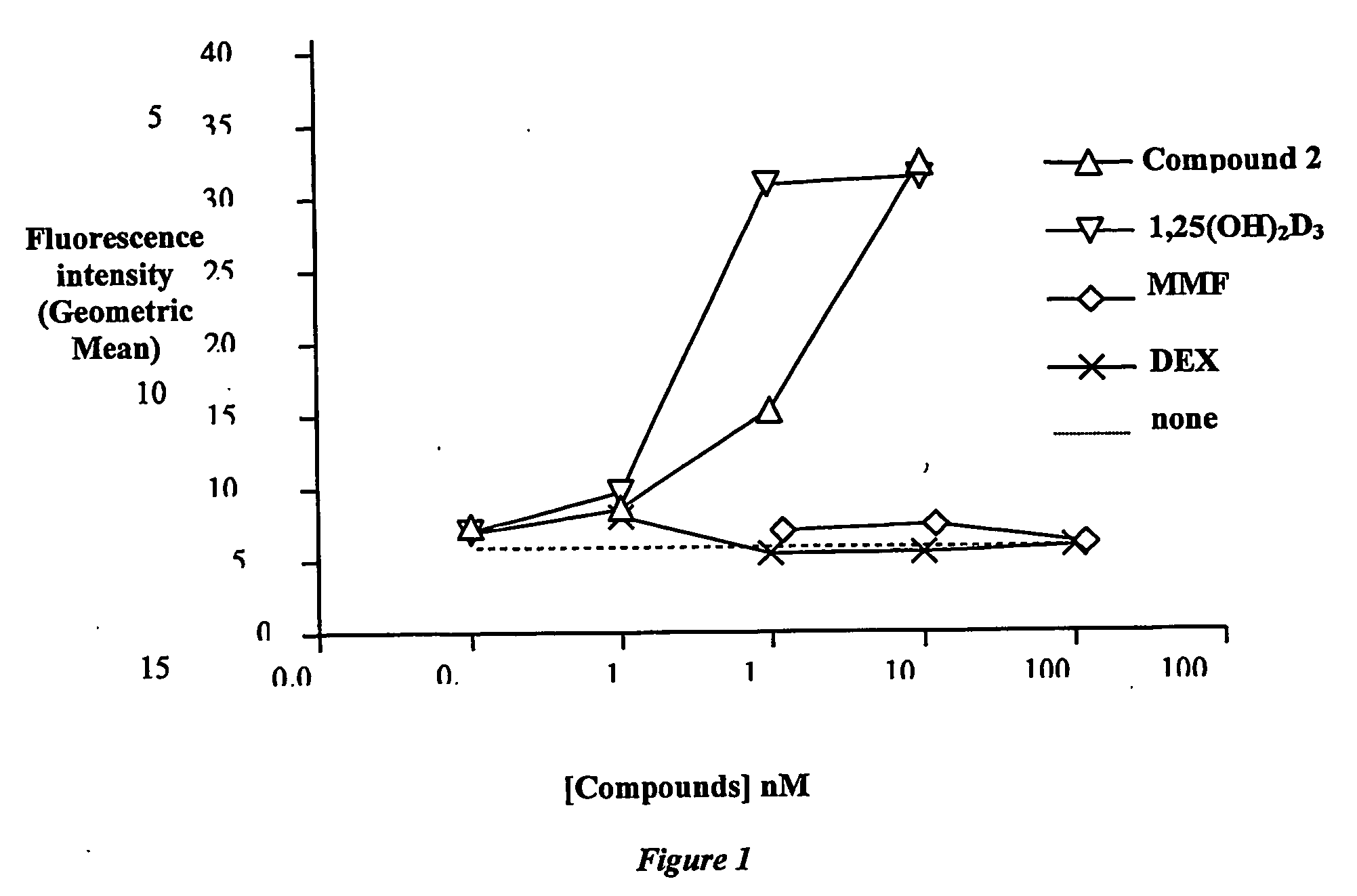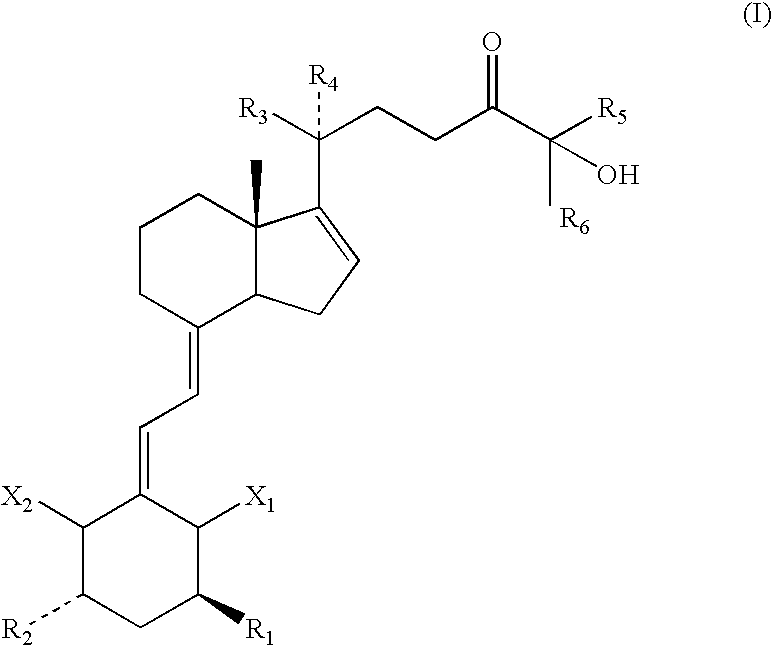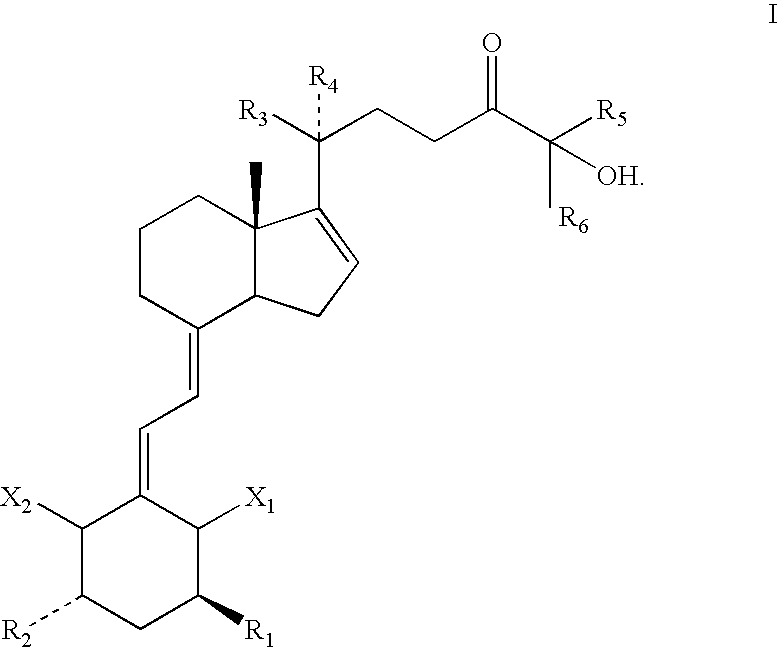1,3 Aclyated 24-keto-vitamin d3 compounds and methods of use thereof
a technology of vitamin d and aclysing compounds, applied in the field of 1, 3 aclysing 24ketovitamin d3 compounds, can solve the problems of limited clinical application of vitamin d and its structural analogs, and achieve the effect of modulating immunosuppressive activity and modulating immunosuppressive activity
- Summary
- Abstract
- Description
- Claims
- Application Information
AI Technical Summary
Benefits of technology
Problems solved by technology
Method used
Image
Examples
example 1
Synthesis of 1,3-O-Diacetyl-1,25-Dihydroxy-16-ene-24-Keto-19-nor-Cholecalciferol (2)
[0209] Referring to Scheme 2, 0.032 g of 1,25-dihydroxy-16-ene-24-keto-19-nor-cholecalciferol (1) was dissolved in 0.8 ml pyridine, cooled in bath and treated with 0.2 ml acetic anhydride for 7 hours at room temperature and for 14 hours in a refrigerator. It was then diluted with 1 ml of water, stirred for 10 min in an ice bath, diluted with 5 ml water and 20 ml ethyl acetate. The organic layer was washed with 3×5 ml of water, then with 5 ml saturated sodium bicarbonate, then with brine, dried over sodium sulfate and evaporated. The oily residue was taken up in 1:6 ethyl acetate-hexane, then flash chromatographed on a 13.5×110 mm column using 1:6 ethyl acetate-hexane as mobile phase for fractions 1-5, 1:4 ethyl acetate-hexane for the remaining fractions. Fractions 11-14 were pooled and evaporated to give 0.0184 g of the title compound (2).
example 2
Deternination of Maximun Tolerated Dose (MTD) of 1,3-O-Diacetyl-1,25-Dihydroxy-16-ene-24-Keto-19-nor-Cholecalciferol (2)
[0210] The maximum tolerated dose of the vitamin D3 compounds of the invention were determined in eight week-old female C57BL / 6 mice (3 mice / group) dosed orally (0.1 ml / mouse) with various concentrations of Vitamin D3 analogs daily for four days. Analogs were formulated in miglyol for a final concentration of 0.01, 0.03, 0.1 0.3, 1, 3, 10, 30, 100 and 300 μg / kg when given at 0.1 ml / mouse p.o. daily. Blood for serum calcium assay was drawn by tail bleed on day five, the final day of the study. Serum calcium levels were determined using a colorimetric assay (Sigma Diagnostics, procedure no. 597). The highest dose of analog tolerated without inducing hypercalcemia (serum calcium >10.7 mg / dl) was taken as the maximum tolerated dose (MTD). Table 1 shows the relative MTD for compound (2) and compound (1). Notably, compound (2) has an MTD that is more than 300 times gre...
example 3
Inmmunological Assay of 1,3-O-Diacetyl-1,25-Dihydroxy-16-ene-24-Keto-19-nor-Cholecalciferol (2)
[0211] Immature dendritic cells (DC) were prepared as described in Romani, N. et al. (Romani, N. et al. (1996) J. Immunol. Meth. 196:137). IFN-γ production by allogeneic T cell activation in the mixed leukocyte response (MLR) was determined as described in Penna, G., et al., J. Immunol., 164: 2405-2411 (2000).
[0212] Briefly, peripheral blood mononuclear cells (PBMC) were separated from buffy coats by Ficoll gradient and the same number (3×105) of allogeneic PBMC from 2 different donors were co-cultured in 96-well flat-bottom plates. After 5 days, IFN-γ production in the MLR assay was measured by ELISA and the results expressed as amount (nM) of test compound required to induce 50% inhibition of IFN-γ production (IC50). The results are summarised in Table 1.
TABLE 1MTD (mice)INF-γCompoundμg / kgIC50 pM1,25(OH)2D31221,25 Dihydroxy-16-ene-24-Keto-19-129nor Cholecalciferol (1)1,3-O-Diacetyl-1...
PUM
 Login to View More
Login to View More Abstract
Description
Claims
Application Information
 Login to View More
Login to View More - R&D
- Intellectual Property
- Life Sciences
- Materials
- Tech Scout
- Unparalleled Data Quality
- Higher Quality Content
- 60% Fewer Hallucinations
Browse by: Latest US Patents, China's latest patents, Technical Efficacy Thesaurus, Application Domain, Technology Topic, Popular Technical Reports.
© 2025 PatSnap. All rights reserved.Legal|Privacy policy|Modern Slavery Act Transparency Statement|Sitemap|About US| Contact US: help@patsnap.com



